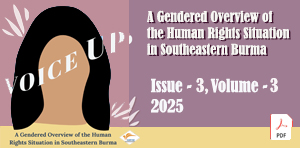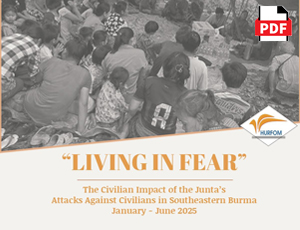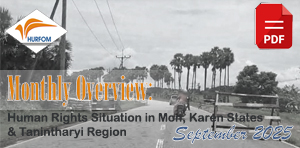September 21, 2016
Burma Army Continues to Act with Impunity: Mon IDP Report Case Study #3
The following case study is from the joint report “Invisible Lives: The Untold Story of Displacement Cycle in Burma” by Human Rights Foundation of Monland (HURFOM), Burma Link, and Burma Partnership, which was launched in a press conference in Rangoon on August 12th and in Moulmein on August 15th. The 65-page report focuses on the continuing concerns of the displaced ethnic nationality communities, particularly the ethnic Mon, living along Burma’s southeast border and finds that the recent reforms have not yet addressed the causes of their displacement. Read more
September 19, 2016
‘I Would Be Happy, If I Could Get Enough Rice’: Mon IDP Report Interview #3
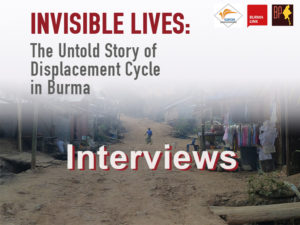 The following interview was conducted as part of the research for the joint report “Invisible Lives: The Untold Story of Displacement Cycle in Burma” by Human Rights Foundation of Monland (HURFOM), Burma Link, and Burma Partnership, which was launched in a press conference in Rangoon on August 12th and in Moulmein on August 15th. The 65-page report focuses on the continuing concerns of the displaced ethnic nationality communities, particularly the ethnic Mon, living along Burma’s southeast border and finds that the recent reforms have not yet addressed the causes of their displacement.
The following interview was conducted as part of the research for the joint report “Invisible Lives: The Untold Story of Displacement Cycle in Burma” by Human Rights Foundation of Monland (HURFOM), Burma Link, and Burma Partnership, which was launched in a press conference in Rangoon on August 12th and in Moulmein on August 15th. The 65-page report focuses on the continuing concerns of the displaced ethnic nationality communities, particularly the ethnic Mon, living along Burma’s southeast border and finds that the recent reforms have not yet addressed the causes of their displacement.
Landmine Victim in Jo Haprao, Bee Ree: Mon IDP Report Case Study #2
September 14, 2016
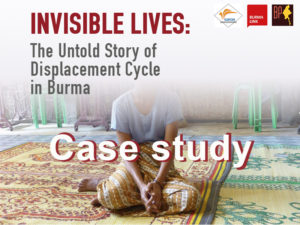 The following case study is from the joint report “Invisible Lives: The Untold Story of Displacement Cycle in Burma” by Human Rights Foundation of Monland (HURFOM), Burma Link, and Burma Partnership, which was launched in a press conference in Rangoon on August 12th and in Moulmein on August 15th. The 65-page report focuses on the continuing concerns of the displaced ethnic nationality communities, particularly the ethnic Mon, living along Burma’s southeast border and finds that the recent reforms have not yet addressed the causes of their displacement. Read more
The following case study is from the joint report “Invisible Lives: The Untold Story of Displacement Cycle in Burma” by Human Rights Foundation of Monland (HURFOM), Burma Link, and Burma Partnership, which was launched in a press conference in Rangoon on August 12th and in Moulmein on August 15th. The 65-page report focuses on the continuing concerns of the displaced ethnic nationality communities, particularly the ethnic Mon, living along Burma’s southeast border and finds that the recent reforms have not yet addressed the causes of their displacement. Read more
Seeking justice for the murder of two Mon villagers
September 13, 2016
It has already been six months since two Mon villagers, U Moe, 41, and Maung Chit Soe, 21, were shot and killed by Captain Zaw Myo Htet from Light Infantry Battalion 280 (LIB-280) in Magyi Chaung Wa village in southern Ye Township, Mon State.
The victims, both fishermen were shot and killed at midnight on March 8, 2016 when they left home to go fishing. The perpetrator claims that it was an accident. Read more
‘It’s Not Like Before, Now We Don’t Have the Medicine, Not Enough for Us’: Mon IDP Report Interview #2
September 12, 2016
 The following interview was conducted as part of the research for the joint report “Invisible Lives: The Untold Story of Displacement Cycle in Burma” by Human Rights Foundation of Monland (HURFOM), Burma Link, and Burma Partnership, which was launched in a press conference in Rangoon on August 12th and in Moulmein on August 15th. The 65-page report focuses on the continuing concerns of the displaced ethnic nationality communities, particularly the ethnic Mon, living along Burma’s southeast border and finds that the recent reforms have not yet addressed the causes of their displacement. Read more
The following interview was conducted as part of the research for the joint report “Invisible Lives: The Untold Story of Displacement Cycle in Burma” by Human Rights Foundation of Monland (HURFOM), Burma Link, and Burma Partnership, which was launched in a press conference in Rangoon on August 12th and in Moulmein on August 15th. The 65-page report focuses on the continuing concerns of the displaced ethnic nationality communities, particularly the ethnic Mon, living along Burma’s southeast border and finds that the recent reforms have not yet addressed the causes of their displacement. Read more
New Mon State Party and Mon farmers initiated Mon Regional Land Policy discussions
September 12, 2016
A workshop was held on 4 and 5 September 2016 to discuss the development of a Mon Regional Land Policy in order to guarantee ethnic Mon people have rights to land. Over 120 representatives, comprised of leaders from four areas of the New Mon State Party (NMSP), civil society organizations (CSOs) including the Human Rights Foundation of Monland (HURFOM), and farmers from 14 townships. The representatives from farming communities have repeatedly reported the complexity of land issues in Mon areas, especially land grabbing and land confiscations by both the Burmese Army and investment companies. The difficulty lies in the registration of the land; the 2012 land law is in favor of companies and the Army, not the local people. Read more
Divorced midwife embarrassed by cyber-bully
September 12, 2016
It is reportedly known that a divorced midwife from Northern A-nin Village, Thanbyuzayat Township, Mon State has been targeted by a cyber-bully. It has been said that the perpetrator is her former husband who lives in Kyat Zu Taw Village, Lat Pan Shay Village Track, Taung Twin Gyi Township, Magway Division. She left her husband on July 20, 2016. The couple does not live near each other and have therefore not been able to end their marriage legally. Read more
Fleeing Sexual Violence from Yebyu Township to the Thailand-Burma Border: Mon IDP Report Case Study #1
September 7, 2016
 The following case study is from the joint report “Invisible Lives: The Untold Story of Displacement Cycle in Burma” by Human Rights Foundation of Monland (HURFOM), Burma Link, and Burma Partnership, which was launched in a press conference in Rangoon on August 12th and in Moulmein on August 15th. The 65-page report focuses on the continuing concerns of the displaced ethnic nationality communities, particularly the ethnic Mon, living along Burma’s southeast border and finds that the recent reforms have not yet addressed the causes of their displacement.
The following case study is from the joint report “Invisible Lives: The Untold Story of Displacement Cycle in Burma” by Human Rights Foundation of Monland (HURFOM), Burma Link, and Burma Partnership, which was launched in a press conference in Rangoon on August 12th and in Moulmein on August 15th. The 65-page report focuses on the continuing concerns of the displaced ethnic nationality communities, particularly the ethnic Mon, living along Burma’s southeast border and finds that the recent reforms have not yet addressed the causes of their displacement.
Download the full report (PDF) in English
Download the full report (PDF) in Burmese
The following is the first case study in a series that HURFOM, Burma Link and Burma Partnership will be publishing in the coming weeks along with a series of selected interviews. The series is meant to give more in depth understanding into the situation of Mon IDPs and villagers. See methodology in the report.
————————————————————————————————————–
Fleeing Sexual Violence from Yebyu Township to the Thailand-Burma Border1: Case Study 1
Mi Sanda Si Aye’s2 mother passed away when she was 18 years old. As the eldest sibling, she took on the role of a mother for her younger siblings. Their father was a fisherman who was often away at sea, and Mi Sanda Si Aye struggled to put food on the table while trying to protect herself and the family from the harassment they often received from the Burma Army.
“I remembered what my aunt had told me; to carry my youngest brother, so they would think I’m a mother with a baby,” Mi Sanda Si Aye says as she recalls one of the times that the Burma Army soldiers came to her house. Her aunt had always reminded her to carry her youngest brother as the soldiers were less likely to take her away to rape her if she was carrying a baby. The houses were far away from each other, and a cry for help would not have been heard between the living quarters. Any time the Burma Army soldiers arrived to her village, men would run and hide to escape forced portering duties that would sometimes last for months. When the men were away, women stayed in the village, becoming easy prey for the soldiers. To protect themselves, the village women slept under the same roof in groups; “If something happened to one of us, the rest of us could scream for help,” Mi Sanda Si Aye explained. The soldiers often returned for information regarding Mon soldiers, leading to threats and interrogation of the villagers. Mi Sanda Si Aye’s cousin once visited a friend in a neighboring village, and upon his arrival, was interrogated, tortured, and finally beaten to death.
When Mi Sanda Si Aye was 19-years-old, she decided to leave the village and take her younger siblings to a safer place. They followed their aunts and walked across the jungle to the Thailand-Burma border. Mi Sanda Si Aye and her family stayed in a refugee camp in Thai-land until they were forced to move back to Burma in 1995. Along with thousands of others, Mi Sanda Si Aye moved to Halockhani IDP site where she has lived for over 20 years. Due to difficulties in making ends meet, her husband is now working in Thailand and sending money to her and their three children. Although she hasn’t faced abuse for decades, Mi Sanda Si Aye says she is still afraid of the Burma Army soldiers because of her experience from the past.
The soldiers tried to take a girl and a mother would pull and grab her daughter tight. By the mother’s scream asking for help, the soldiers didn’t get her daughter. When I saw and heard this kind of story several times, I didn’t dare to live in the village anymore. (Mi Sanda Si Aye)
————————————————————————————————————-
- Mon IDP, FGD and interview with author, Halockhani, 27 February 2016.
- Name has been changed to protect the identity of the individual.
Police conduct an investigation into drugs, sex and firearms trade
September 7, 2016
During August 2016, the local army, local police, special police, border guard forces and the Criminal Investigation Department (CID) Yangon have launched a cooperative mission to eliminate drugs, sex and firearms trade in the town of Three Pagodas Pass (TPP) located by the Thai-Burma Border. Read more
Telenor cell phone tower disturb villagers
September 7, 2016
Telenor Burma, a major mobile operator in Burma, has established its cell phone tower near Kyaung How Monastery in A-lae (middle) Ward in Kwan Sart Village, Thanbyuzayat Township, Mon State. The monks in the monastery, children in a nearby kindergarten and villagers who live near the towers are tired from the disturbance caused by the tower. Read more




